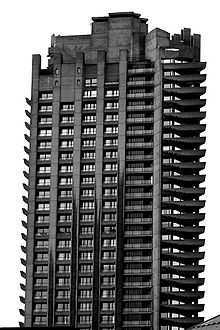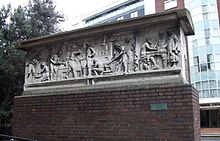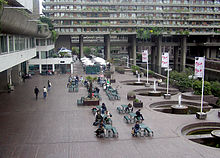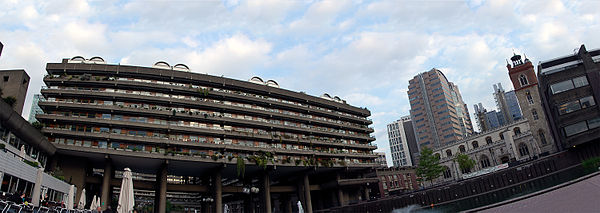- Barbican Estate
-
The Barbican Estate is a residential estate built during the 1960s and the 1970s in the City of London, in an area once devastated by World War II bombings and today densely populated by financial institutions. It contains, or is adjacent to, the Barbican Arts Centre, the Museum of London, the Guildhall School of Music and Drama, the Barbican public library, the City of London School for Girls and a YMCA, forming the Barbican Complex. The complex is a prominent example of British brutalist architecture and, with the exception of Milton Court (which contained a fire station, medical facilities and some flats), is Grade II listed as a whole.[1]
Contents
History
Frieze recovered from Bryers and Sons building at 53 and 54 Barbican which survived wartime bombing but was demolished to make way for the redevelopment
During World War II, the City suffered serious damage and loss of life. The Cripplegate area was virtually demolished and by 1951 the resident population of the City stood at 5,324 of whom 48 lived in Cripplegate. Discussions began in 1952 about the future of the site, and the decision to build new residential properties was taken by the Court of Common Council on 19 September 1957.[2]
The estate was built between 1965 and 1976, on a 35-acre (140,000 m2) site that was bombed in World War II.The complex was designed by architects Chamberlin, Powell and Bon, whose first work was the earlier, ground-breaking Golden Lane Estate immediately North of Barbican. The estate of 40 acres (160,000 m2) was officially opened in 1969 and is now home to around 4,000 people living in 2,014 flats.[2] The flats reflect the widespread use in Britain in the 1960s and 1970s of concrete as the visible face of the building.
The Minister for the Arts, Tessa Blackstone, announced in September 2001 that the Barbican complex was to be Grade II listed. It has been designated a site of special architectural interest for its scale, its cohesion and the ambition of the project.[3] The complex is architecturally important as it is one of London's principal examples of concrete Brutalist architecture and considered a landmark.
Blocks and towers
The residential estate consists of 13 terrace blocks, grouped around the lake and green squares within the complex. The main buildings rise for up to seven floors above a podium level, which links all the facilities in the Barbican, providing a pedestrian route above street level. Some maisonettes are built into the podium structure. There is no vehicular access within the estate, but there are some car parks at the periphery of the estate. Public car parks are located within the Barbican centre.
The estate also contains three of London's tallest residential towers, at 42 storeys and 123 metres (404 ft) high. The top two or three floors of each block comprise three penthouse flats. The towers are (east to west):
- Cromwell Tower, completed in 1973 - named after Oliver Cromwell;[4]
- Shakespeare Tower, completed in 1976 - named after William Shakespeare;[5] and
- Lauderdale Tower, completed in 1974 - named after the Earls of Lauderdale.[6]
Once the tallest residential towers in London, they were surpassed by the Pan Peninsula development near Canary Wharf.
Barbican complex
The Barbican Estate also contains the Barbican Centre (an arts, drama and business venue), the Barbican public library, the City of London School for Girls, the Museum of London, and the Guildhall School of Music and Drama. A YMCA building was constructed between 1965 and 1971[3] to link the Barbican and Golden Lane Estate, it is also listed.
Nearby rail and Tube
- Liverpool Street (Central, Circle, Hammersmith & City and Metropolitan lines).
- Barbican (Circle, Hammersmith & City and Metropolitan lines).
- Moorgate (Northern (city branch), Circle, Hammersmith & City and Metropolitan lines)
- St. Paul's (Central Line)
- Farringdon (Circle, Hammersmith & City and Metropolitan lines)
See also
References and notes
- ^ Details from listed building database (1352667). National Heritage List for England. English Heritage. Retrieved 12 June 2011.
- ^ a b "History of the Barbican Estate". City of London. Archived from the original on 2006-12-07. http://web.archive.org/web/20061207192334/http://www.cityoflondon.gov.uk/Corporation/our_services/barbican_estate/history.htm. Retrieved 2007-01-11.
- ^ a b "Listing of the Barbican complex". City of London. Archived from the original on 2006-10-08. http://web.archive.org/web/20061008192733/http://cityoflondon.gov.uk/Corporation/our_services/barbican_estate/listing.htm. Retrieved 2007-01-11.
- ^ "Cromwell Tower". Emporis Buildings. http://www.emporis.com/en/wm/bu/?id=110659. Retrieved 2007-01-11.
- ^ "Shakespeare Tower". Emporis Buildings. http://www.emporis.com/en/wm/bu/?id=110661. Retrieved 2007-01-11.
- ^ "Lauderdale Tower". Emporis Buildings. http://www.emporis.com/en/wm/bu/?id=110660. Retrieved 2007-01-11.
External links
- The history of the Barbican Estate
- Corporation of London:Barbican Estate
- Barbican Living website
- Barbican Talk residents' forum
- 'Secret bits of the Barbican', Londonist
Coordinates: 51°31′09″N 0°05′38″W / 51.51917°N 0.09389°W
City of London Wards Aldersgate · Aldgate · Bassishaw · Billingsgate · Bishopsgate · Bread Street · Bridge · Broad Street · Candlewick · Castle Baynard · Cheap · Coleman Street · Cordwainer · Cornhill · Cripplegate · Dowgate · Farringdon Within · Farringdon Without · Langbourn · Lime Street · Portsoken · Queenhithe · Tower · Vintry · Walbrook
Enclaves Localities Attractions Bank of England Museum · Barbican Centre · Clockmakers' Museum · Dr. Johnson's House · Guildhall Art Gallery · London Mithraeum · London Stone · Mansion House · The Monument · Museum of London · Old Bailey · St. Paul's Cathedral · Smithfield MarketCivil parishes Bridges Tube and rail stations  Category ·
Category ·  CommonsCategories:
CommonsCategories:- Brutalist buildings in the United Kingdom
- Buildings and structures in the City of London
- Grade II listed buildings in London
- Housing estates in London
- Skyscrapers in the City of London
- Residential skyscrapers
- Skyscrapers between 100 and 149 meters
- Barbican Estate
Wikimedia Foundation. 2010.




